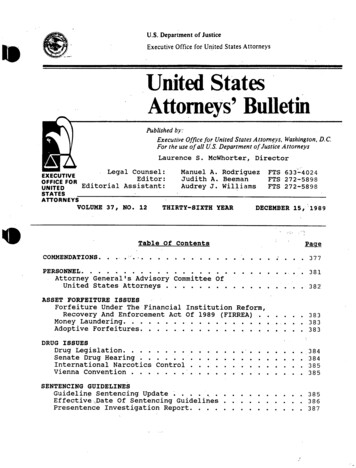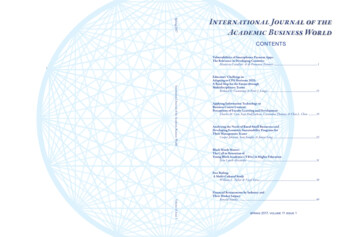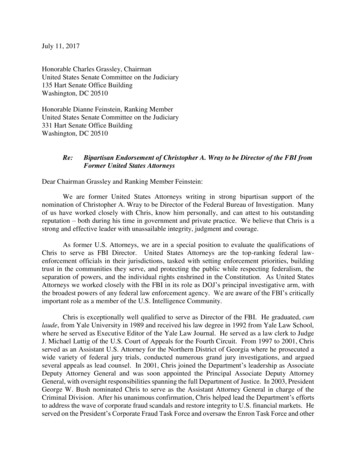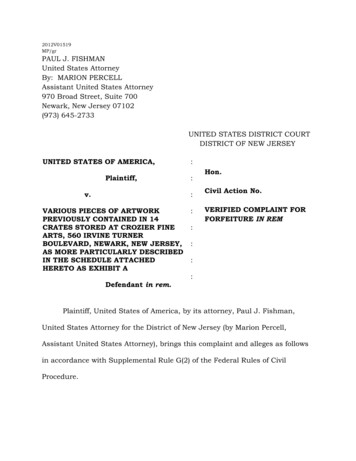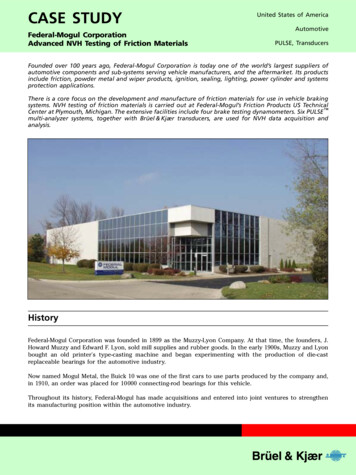
Transcription
CASE STUDYFederal-Mogul CorporationAdvanced NVH Testing of Friction MaterialsUnited States of AmericaAutomotivePULSE, TransducersFounded over 100 years ago, Federal-Mogul Corporation is today one of the world’s largest suppliers ofautomotive components and sub-systems serving vehicle manufacturers, and the aftermarket. Its productsinclude friction, powder metal and wiper products, ignition, sealing, lighting, power cylinder and systemsprotection applications.There is a core focus on the development and manufacture of friction materials for use in vehicle brakingsystems. NVH testing of friction materials is carried out at Federal-Mogul’s Friction Products US TechnicalCenter at Plymouth, Michigan. The extensive facilities include four brake testing dynamometers. Six PULSE multi-analyzer systems, together with Brüel & Kjær transducers, are used for NVH data acquisition andanalysis.HistoryFederal-Mogul Corporation was founded in 1899 as the Muzzy-Lyon Company. At that time, the founders, J.Howard Muzzy and Edward F. Lyon, sold mill supplies and rubber goods. In the early 1900s, Muzzy and Lyonbought an old printer's type-casting machine and began experimenting with the production of die-castreplaceable bearings for the automotive industry.Now named Mogul Metal, the Buick 10 was one of the first cars to use parts produced by the company and,in 1910, an order was placed for 10000 connecting-rod bearings for this vehicle.Throughout its history, Federal-Mogul has made acquisitions and entered into joint ventures to strengthenits manufacturing position within the automotive industry.
Today, Federal-Mogul is a global supplier of automotive components and sub-systemsserving the world's vehicle manufacturers, and the aftermarket. Its products include: Friction, powder metal and wiper productsIgnition, sealing, lighting, pistons and power cylinder systemsSystems protectionThe company utilises its engineering and materials expertise, state-of-the-art technology,manufacturing skills, distribution flexibility and marketing power to deliver products,brands and services to its customers throughout the world. With its headquarters inSouthfield, Michigan, Federal-Mogul about employs 56 000 people in 24 countries, andhas a turnover of over US 6 billion.Federal-Mogul’s global manufacturing facilities are accredited to ISO 9001and ISO 9002.Friction ProductsFig. 1Two of FederalMogul’s LinkEngineeringclimatic braketestingdynamometersFriction products are a core business ofFederal-Mogul. Its Friction Products Technical Center was first commissioned in1996. This facility in Livonia, Michigan,extended to some 9000 sq.ft. The demands for NVH testing grew rapidly andas a result, in mid 2002, the company relocated its technical centre to a new34 000 sq.ft. facility in Plymouth, Michigan. It is close to Federal-Mogul’s majorUS customers, is highly efficient and cost-effective.There is a technical centre in each country where Federal-Mogul manufactures frictionmaterials, for example, USA, Brazil, Mexico, Czech Republic, Thailand, China, SouthAfrica, Italy, Spain, France, Germany and UK. There is a joint-venture operation in Japan.Fig. 2The interior of oneof the LinkEngineeringdynamometers.Brüel & KjærMicrophone Type4189 is fixed at aspecified distancefrom the face ofthe brake, disc orpad, being testedThe technical centres are the ‘interface’between Federal-Mogul’s R&D departments and vehicle and brake manufacturers. The facility in Plymouth is focusedon application engineering.Federal-Mogul’s Development Center atSmithville, Tennersee, is the R&D centrewhere new materials, brakes and systemsare developed. Durability testing is alsocarried out at Smithville.Federal-Mogul’s friction products areused in the manufacture of brake discsand pads for passenger cars up to thelargest trucks. The company is a global market leader and supplies friction materialsto many of the world's leading brake manufacturers including TRW, Bosch, Continental,PBR, Ferodo, Wagner and Delphi.When developing friction materials, a large number of parameters must be considered.These include wear, brake life, weight, vehicle inertia, performance, cost, productionvolume, and especially safety. The Federal Motor Vehicle Safety Standard (FMVSS)specifies the stopping distance for different classes of vehicle.2
These factors together affect the choice of materials. Federal-Mogul has a strong focuson the use of environmentally friendly NAO (non-asbestos organic, no metal) materials.Asbestos dust from truck brakes is an ever-increasing environmental issue throughoutthe world. It is thought that dust from brakes made using asbestos impacts on watersupplies and thus passes into the human chain. In addition, Federal-Mogul also develops‘low-met’ (metal with no asbestos – used in Europe) and ‘semi-met’ (metal with noasbestos – used in mainly for truck brakes).Once the program has been defined, prototype materials are produced and tested fordurability and performance at Federal-Mogul’s Smithville facility. The NVH characteristics of the materials are then tested and analysed at the Friction Products TechnicalCenter at Plymouth.NVH ExperienceFig. 3Murali Venkat isNVH Manager atFederal-Mogul’sfacility atPlymouth,MichiganThe Plymouth Technical Center has some25 employees. Murali Venkat is the NVHManager. He gained his Bachelor’s Degreein India. This was followed by an MS inmechanical engineering from WayneState University. Murali began working atFord in Dearborn, Michigan, in 1991 and,throughout his career, has focused onNVH analysis while working for major automotive manufacturers.He joined Federal-Mogul in 2002 and is especially interested in mathematical modellingusing CAE technology. Murali explains, “Together with our customers, we design uniquebrake material for each vehicle program.”He continues, “Brake squeal is one of the biggest warranty issues in the US and automotive manufactures put great focus on this. The NVH specifications are getting constantly tighter, and are ultimately driven by vehicle customers. R&D check theperformance and make durability tests on new brakes. The brakes, both disc and drum,then come to us for detailed NVH evaluation”.The technical centre at Plymouth currently has four brake-testing dynamometers. Eachdynamometer runs 24 hours a day, 365 days a year. The dynamometer tests are definedby SAE J 2521, AK Noise, etc.Murali adds, “An average NVH test takes 24 hours while the full evaluation processgenerally lasts from two to four weeks. Of course we also make benchmark tests onour competitors products”.A routine noise test uses one microphone channel although special investigations mayuse up to eight. The frequency range of interest is between 1 kHz and 15 kHz. The testdata is A-weighted and so removes the low frequencies. Murali says, “A squeal aboveabout 70 dB(A) is critical – this equates to about 50 dB(A) measured in the vehicle”.PULSEMurali says. “I first used Brüel & Kjær products at university, and I have been usingthem ever since. We currently have six PULSE front-ends”.3
Fig. 4The spaciouscontrol room forthe four braketestingdynamometers“Each of the four brake-testing dynamometers is equipped with a PULSE systemfor data acquisition and analysis. We alsohave a further 8-channel PULSE systemcomprising two 4-channel front-ends.This is dedicated to modal analysis work.Our Link 3501 in-vehicle test system isalso equipped with PULSE for data acquisition.”Fig. 5The PULSEsoftware runs inthe background.The operatorinterface at each ofthe fourdynamometercontrol stations isprovided by LinkEngineering’sProLink software“We have standardised on PULSE so thatall NVH test data is totally compatible.It's a powerful system, intuitive, and easyto set up and use. It also very useful tobe able to stack a number of PULSE unitstogether if a higher number of channelsare needed for a particular test. We canalso split the modal analysis system intotwo separate units if needed. It’s flexible,efficient and convenient”, says Murali.Federal-Mogul’s R&D centre at Smithville also has PULSE. Therefore, test data can easilybe exchanged between this facility and the friction products technical centre. EveryPULSE system runs under Windows 2000.All microphones are Brüel & Kjær Type 4189. These are calibrated before each test usinga Brüel & Kjær Sound Level Calibrator Type 4231. The accelerometers used for modaltesting are Type 4293, also from Brüel & Kjær.Link EngineeringFig. 6Each of the fourbrake testingdynamometers hasits own LinkEngineeringcontrol stationThree of Federal-Mogul’s brake testing dynamometersare manufactured by Link Engineering, the most recentbeing commissioned in March 2003. But each of the fourdynamometers is controlled by its own Link control station, and uses ProLink software. The PULSE software,installed in each PULSE data acquisition system, runs inthe background.Murali continues, “There is a very high demand for NVHtesting and each of the dynamometers runs seven daysa week, 365 days a year. Therefore, reliability is essentialand Link is our dedicated dynamometer platform. Thedynamometers at Smithville also use Link control anddata acquisition systems and a project has started toprovide these facilities at the Federal-Mogul sites inFrance and the UK”.In-vehicle TestingAlthough much of the NVH analysis work carried out at the technical centre, FederalMogul also acquires large amounts of test data from in-vehicle testing under practicalroad conditions.4
For in-vehicle data acquisition, Federal-Mogul uses a Link 3501 system. This is alsoequipped with its own PULSE front-end.Fig. 7Federal-Mogul usesa Link Engineering3501 in-vehicle testsystem.A 4-channel PULSEmulti-analyzeracquires the data“Murali explains, “The Detroit SuburbanTraffic Test (DST) and Detroit City Test(DCT) tests are performed as specified by‘the big three’ (Ford, General Motors andDaimlerChrysler). They each also havetheir own internal standard procedures”.“Brake noise events are recorded using aBrüel & Kjær microphone located close toeach brake-disc or pad. We measure anumber of other parameters including thebrake-pedal pressure (measured on thehydraulic brake-line), the temperature ofeach pad/disc, vehicle speed, etc. Thereis also the Los Angeles City Traffic Test (LACT). This is a test for both noise anddurability.”For NVH testing under extreme conditions, Federal-Mogul makes high ambient temperature tests in Arizona during the summer, in Minneapolis during the winter, and inColorado to test the effects of high altitude. The Link 3501 system is compact andtherefore very convenient for transportation.Data Handling and ReportingFig. 8Frequency responsefunctions (FRFs) canbe measured in aclimatic chamber.The temperature isaccuratelycontrolled from –65 C to 175 C.The data isacquired andanalysed using twostacked 4-channelPULSE front-endsMurali says, “We have a frequent need tocompare data. We plan to acquire PULSEData Manager and this is will prove to bean excellent tool for the archiving, retrieval and comparison of data”.For reporting, a CSV file from the ProLinksoftware is pasted into Excel and detaileda six page report is created. The test datais saved on a database on a central server and placed on Federal-Mogul's intranetso it is available to the R&D departments,technical centres, and manufacturing facilities throughout the world.The FutureMurali says, “We are continuing to make very substantial investments in our test facilityhere at Plymouth. The result is that our testing efficiency is increasing, we save timeand money for our customers, and we are very close to the market. In 2004, we expectto purchase a new laser doppler vibrometer to replace our existing Ometron unit. Thiswill be used to investigate noise sources both in a dynamometer and in the vehicle testarea”.The laser doppler vibrometer can determine vibrations in the 1 kHz to 6 kHz frequencyrange.5
Fig. 9Left: An Ometronlaser dopplervibrometer is usedto investigate thecauses of noise. Theillustration showsthe OperationalDeflection Shape(ODS) of a brakedisc at 5.8 kHzRight: There is awell equippedvehicle test areacomplete withhoists and exhaustextraction system“We we will also start to use Modal Test Consultant Type 7753 and ME’ScopeVES Type 7754. Together, these new applications will greatly help with the expanding useof modal analysis techniques. There will also be an increasing use of mathematicalmodelling using predictive software programs, and this will reduce the amount of initialtesting required during development.”Fig. 10A typical frequencyresponse functiondisplay from abrake pad tested atroom temperature.FRFs can also bemeasured in aclimatic chamber“For instance, we measure the actual frequency response functions (FRFs) to ensure compliance and to improve ourmodelling predictions. I spend much ofmy time working in this area. But therewill be no substitute for practical testingto detect and measure brake-squeal,both using dynamometers and under realdriving conditions.”Murali concludes, “The service and support from Brüel & Kjær’s local office in Livoniais excellent – we regard them as our friends, our partners, and not just as suppliers.” Federal-Mogul is a global supplier of automotive components and sub-systemsThere is a core focus on the development and manufacture of friction materials foruse in vehicle braking systemsNVH testing of friction materials is carried out at Federal-Mogul’s Friction ProductsUS Technical Center at Plymouth, MichiganThe facilities include four brake testing dynamometers and Seven PULSE systems“Brake squeal is one of the biggest warranty issues in the US“NVH specifications are getting constantly tighter, ultimately driven by customers”“We have standardised on PULSE so that all NVH test data is totally compatible”Each dynamometer is controlled by a Link control station, using ProLink software“Reliability is essential and Link is our dedicated dynamometer platform”“PULSE Data Manager is proving to be an excellent tool for the archiving, retrievaland comparison of data”“The service and support from Brüel & Kjær’s local office in Livonia is excellent – weregard them as our friends, our partners, and not just as suppliers”HEADQUARTERS: DK-2850 Nærum · Denmark · Telephone: 45 4580 0500 · Fax: 45 4580 1405 · www.bksv.com · info@bksv.comAustralia ( 61) 2 9889-8888 · Austria ( 43) 1 865 74 00 · Brazil ( 55)11 5188-8166 · Canada ( 1) 514 695-8225 · China ( 86) 10 680 29906Czech Republic ( 420) 2 6702 1100 · Finland ( 358) 9-755 950 · France ( 33) 1 69 90 71 00 · Germany ( 49) 421 17 87 0Hong Kong ( 852) 2548 7486 · Hungary ( 36) 1 215 83 05 · Ireland ( 353) 1 807 4083 · Italy ( 39) 0257 68061 · Japan ( 81) 3 3779 8671Republic of Korea ( 82) 2 3473 0605 · Netherlands ( 31)318 55 9290 · Norway ( 47) 66 77 11 55 · Poland ( 48) 22 816 75 56Portugal ( 351) 21 47 11 4 53 · Singapore ( 65) 377 4512 · Slovak Republic ( 421) 25 443 0701 · Spain ( 34) 91 659 0820Sweden ( 46) 8 449 8600 · Switzerland ( 41) 1 880 7035 · Taiwan ( 886) 2 2502 7255 · United Kingdom ( 44) 14 38 739 000USA ( 1) 800 332 2040 · Local representatives and service organisations worldwideBA 0567 11 04/01Key Facts
The Plymouth Technical Center has some 25 employees. Murali Venkat is the NVH Manager. He gained his Bachelor's Degree in India. This was followed by an MS in mechanical engineering from Wayne State University. Murali began working at Ford in Dearborn, Michigan, in 1991 and, throughout his career, has focused on NVH analysis while working for .





